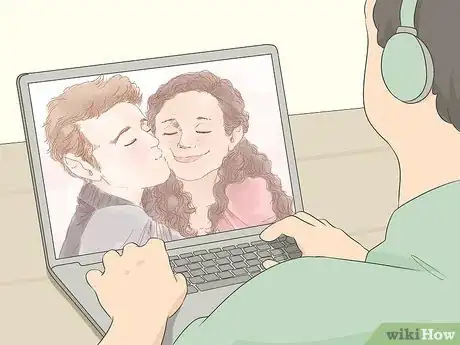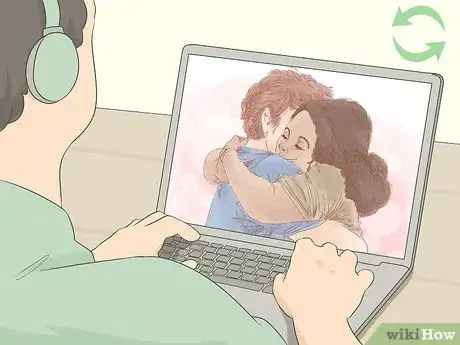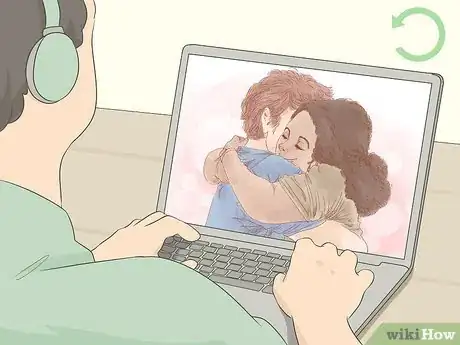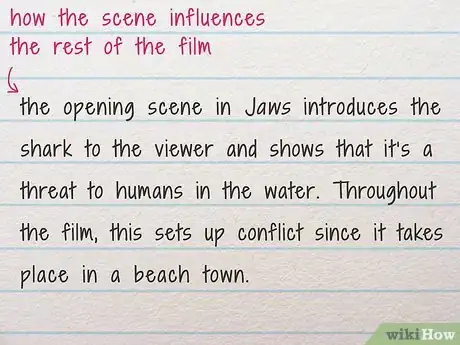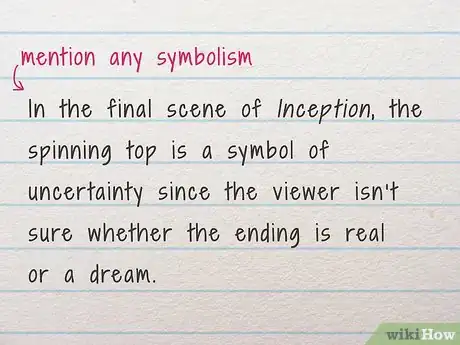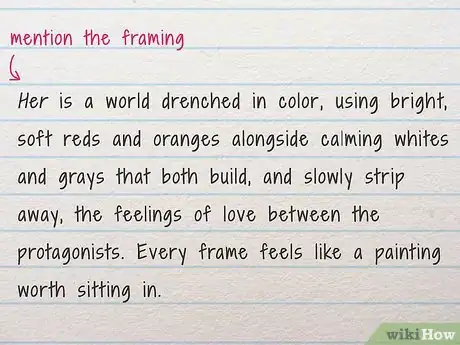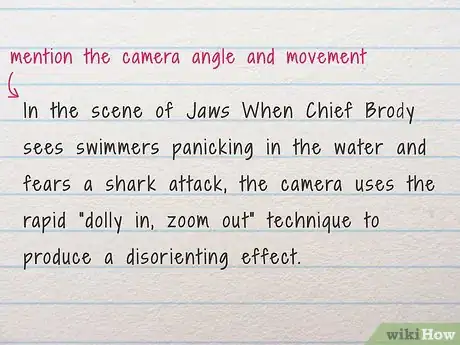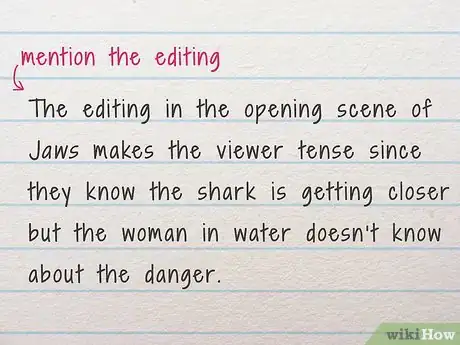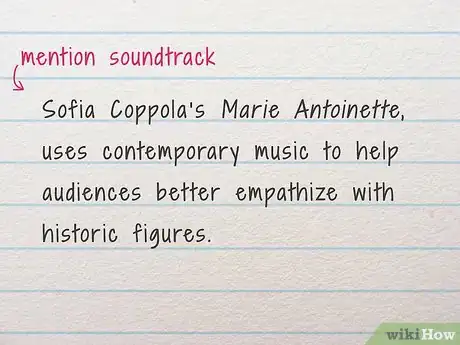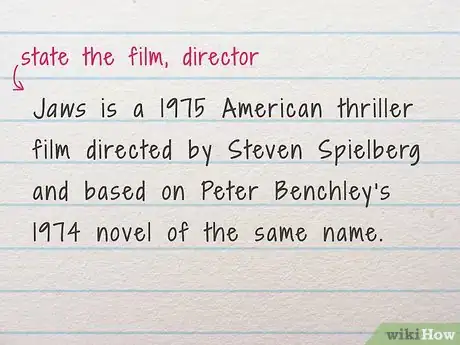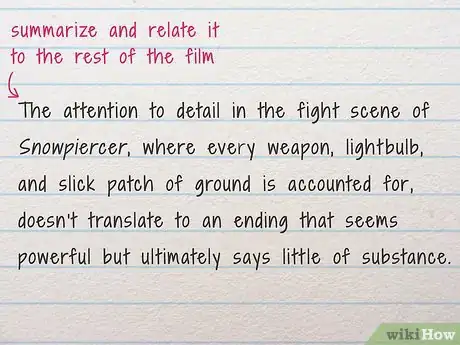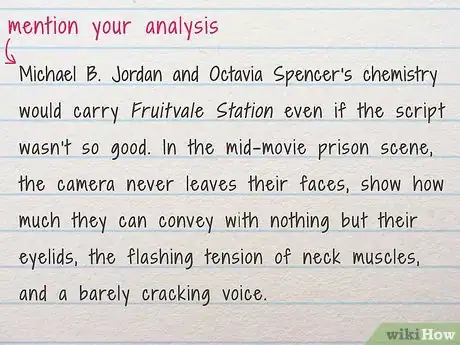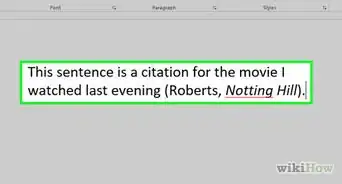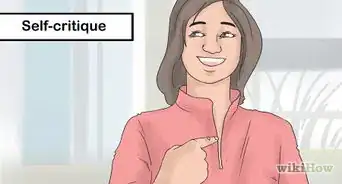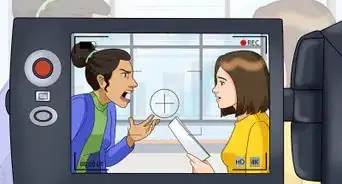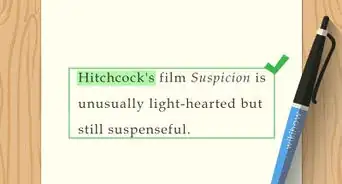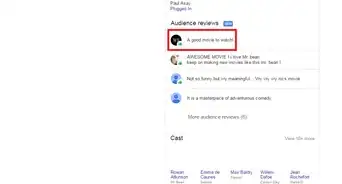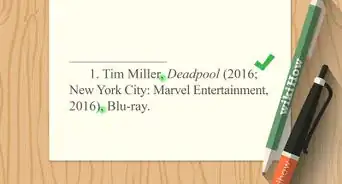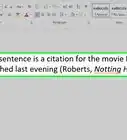This article was co-authored by Gavin Anstey and by wikiHow staff writer, Hunter Rising. Gavin Anstey is the COO at Cinebody. Cinebody is User-Directed Content software that empowers brands to create instant, authentic, and engaging video content with anyone on earth. Gavin studied Journalism at the University of Colorado Boulder, before launching a career in video production and software.
There are 11 references cited in this article, which can be found at the bottom of the page.
wikiHow marks an article as reader-approved once it receives enough positive feedback. This article has 11 testimonials from our readers, earning it our reader-approved status.
This article has been viewed 312,672 times.
While you can analyze an entire film, you can also choose a scene from the movie and break it down even further. Before you choose a scene you want to analyze, watch the entire film first so you can understand what’s happening. Go over the scene you want to analyze multiple times so you can pick out the details and take notes on it. Once you have your notes, you can write a formal analysis essay about the scene.
Steps
Choosing and Watching the Scene
-
1Watch the entire film without any distractions to understand the theme. Pick a film that interests you to watch for your analysis. The first time you watch it, pay full attention so you can understand the story and what’s happening in the scenes. Put your phone on silent or vibrate and set it aside while you’re watching the movie so you don’t get distracted by it during the film. Once the film is finished, jot down the overlying theme that you recognized.[1]
- For example, if you choose to watch the movie To Kill a Mockingbird, you may say the overlying theme is the balance of good and evil or how prejudice can affect a town.
Tip: The film may have multiple themes, so choose one that interests you to focus on and use it to apply to the scene you choose later.
-
2Go through the film again to find a scene you want to analyze. Scan through the film for a scene that’s about 2-5 minutes in length for your analysis. Find a scene that’s important to the rest of the story rather than a moment that doesn’t add to it. Consider the elements of the scene you can analyze when you choose your scene, such as the acting, editing, cinematography, or plot.[2]
- For example, if you want to analyze Jaws, you may choose the opening scene to see how music and cinematography affect the mood.
- Analyzing scenes that are just conversations between characters can be just as fun as focusing on a big action scene. With quieter scenes, you can discuss how the camera angles and dialog affect how someone interprets the conversations.
Advertisement -
3Replay the scene multiple times to focus on what’s happening on screen. Set aside any distractions and rewatch the scene you chose at least 2-3 times. Pay attention to the main actions and the moods of the characters in the scene and think about how they relate to the rest of the film.[3]
- Avoid taking any notes the first couple times you watch the scene so you can absorb as much of it as you can. After 2-3 viewings, you can start pausing the scene or writing down things you notice.
Analyzing Elements within the Scene
-
1Summarize the main actions occurring in the scene. Write down the events that occur in the scene in the order they happen so you have a general understanding of what’s happening. Include what the characters are talking about while you list the main actions of the scene. Don’t list every single shot from the scene, but every time something happens that moves the scene forward.[4]
- For example, the events of the opening scene in Jaws are teenagers partying on a beach, two of the people leaving the group, one of them swimming in the water, and then getting grabbed by the shark.
EXPERT TIPGavin Anstey is the COO at Cinebody. Cinebody is User-Directed Content software that empowers brands to create instant, authentic, and engaging video content with anyone on earth. Gavin studied Journalism at the University of Colorado Boulder, before launching a career in video production and software.Video Producer, COO at Cinebody
 Gavin Anstey
Gavin Anstey
Video Producer, COO at CinebodyWhat are the main elements of a scene? Gavin Anstey, a video producer, tells us: "Lighting is always an important element. Is it natural lighting, or artificial? Lighting sets the mood of the scene. Next is the talent if they are in the scene. How good is the talent? The majority of communication isn't verbal language, it's body language. How does the talent evoke a feeling or emotion without saying anything? Finally, does the talent sound real and authentic? Or do they sound cheesy?"
-
2Determine how the scene fits in with the story of the film. Look at your scene from a wider perspective so you can understand how it influences the rest of the film. Pay attention to the scenes that come before and after the one you chose. Write down what information the scene gives you about the film that’s important or thematic later on.[5]
- For example, the opening scene in Jaws introduces the shark to the viewer and shows that it’s a threat to humans in the water. Throughout the film, this sets up conflict since it takes place in a beach town.
-
3Watch the characters for their body language, dialogue, and motivations. Start by taking note of which characters are present in the scene, and list what you know about them based on the rest of the film, such as their goals and personalities. Watch the actors perform and pay attention to how they move and interact with one another. Listen to the dialogue and determine how their lines relate to the plot of the film or the relationships the character has.[6]
- For example, in the shark attack scene from Jaws, you may notice the kids in the water having fun, but Chief Brody is tense and worried about everyone’s safety.
Tip: Pay attention to the characters’ costumes since they could give hints about the character’s intentions. For example, if the character is wearing dark clothes, they may be evil or they could be planning something sinister.
-
4See if there’s any symbolism in the scene. Symbols in a film can be and audio or visual cue that you relate to an emotion, mood, or action. Watch the scene again and pay attention to any important props or recurring images. Write down anything that catches your eye and brainstorm what they mean in reference to the scene and the film as a whole.[7]
- For example, in the final scene of Inception, the spinning top is a symbol of uncertainty since the viewer isn’t sure whether the ending is real or a dream.
- Another example is the letter “X” or an X-shape in a scene of the film The Departed, which represents death.
- Even characters can be symbols. For example, the Joker in The Dark Knight can be a symbol of chaos or uncertainty.
- Not every scene will have specific symbols that relate to the rest of the film, so don’t worry about if you can’t find any.
-
5Look at the framing of the scene to how it’s composed. The framing, or mise-en-scène, of a film refers to how the elements of the shot are arranged on screen. Pause the scene often and look and how the actors and set decoration are positioned on screen. Take note of the objects that are closest and furthest away from the camera to understand what’s prominent in the scene.[8]
- For example, if a character is standing and looking down at another character that’s sitting down, it could mean the standing character is more important or powerful than the other.
- If you’re watching the film on a computer, take screenshots from the scene so you can analyze the still frames.
- Look at how the scene’s lit and how the highlights and shadows affect the mood. Shots that are framed dark can make the scene mysterious but well let scenes may seem like a comfortable or exposed location.[9]
-
6Watch the camera angle and movement to see how they change the feeling of the scene. The camera angle refers to how much you can see in the frame and what the viewer should focus on. Write down if the camera moves around often or if it stays in one place since this can add to the overall feeling and tension of the scene. Pay attention to what fills the frame during your scene and if there are a lot of close-ups or wide shots where you can see a lot.[10]
- For example, action scenes usually have a lot of movement and have multiple angles to keep the viewer excited. Conversely, horror scenes may have no camera movement and close-up shots to make a viewer feel tense while they’re watching it.
- Make note of when shots shift focus from an object or character to another.
-
7Notice how the editing from shot to shot conveys a mood. The editing refers to the changes between shots during your scene and how they affect how a viewer experiences it. Make note of how the transition between shots affect one another and how fast they occur. Write down how the changes between the shots affect the mood of the scene.[11]
- For example, if you have a shot of a desert followed by a shot of a glass of water, it may make you think about being thirsty.
- In another example, the editing in the opening scene of Jaws makes the viewer tense since they know the shark is getting closer but the woman in water doesn’t know about the danger.
-
8Listen to how the sound effects or music affect the mood of the scene. Close your eyes and listen to the scene so you can focus on the music and sound effects. Then watch the scene again with your eyes open to see how the sound lines up with the editing and the character actions. Make note of how the sounds affect the overall mood set by the rest of the scene.[12]
- For example, the music at the beginning of Jaws helps to build tension since it keeps getting faster until the shark attacks.
- Wear headphones and play the scene if you’re able so you’re able to catch all of the discrete noises you may not have been able to hear otherwise.
- Make note of silences in the scene as well since they can be just as important as loud sounds.
Writing a Scene Analysis
-
1Brainstorm a thesis that will be the main point of your analysis. Look at the notes you took on the scene and compare them to the overall theme of the film. Pick a topic for your analysis that you can support with multiple elements from the scene so you can expand and defend your argument. Write down the thesis in a single, concise sentence.[13]
- For example, a thesis for the opening scene in Jaws may be, “The opening shark attack from Jaws uses accelerating music, quick editing, and point of view shots to create tension.”
-
2State the film, director, and thesis you’re writing about in your introduction. Open your analysis with an attention-grabbing sentence that relates to the film or the theme of the scene. Mention the name of the film, the director, and the year it was released in the next sentence. At the end of the introduction, write your thesis so the reader knows what to expect from the rest of the paper.[14]
- Keep your introduction about 3-4 sentences long.
-
3Summarize the scene and how it relates to the rest of the film. Use the next paragraph to describe the actions that happen in the scene in chronological order so the reader knows you’re talking about. Then add a sentence or 2 to the end of the paragraph to discuss how your scene fits with the themes and the events for the rest of the film.[15]
- Keep the summary paragraph about 4-5 sentences long before moving on.
-
4Include at least 2-3 paragraphs about what you analyzed for the body of your paper. Aim to have about 2-3 paragraphs that each discuss a separate element from the scene that defends your thesis statement. Use examples from the scene to support the claims you’re making in your body paragraphs. Expand on how the elements of the scenes affect the mood and the rest of the film.[16]
- For example, if you’re talking about the opening scene in Jaws, your body paragraphs may discuss the music, the editing, and the point of view of the camera angles.
- Don’t use all of your notes you took from the scene since they won’t all fit with the thesis for your paper.
-
5Conclude your paper by restating your thesis and main points of your essay. Reword your thesis statement to restate the main idea of your paper for the first sentence in your conclusion. Then use the next 2-3 sentences to summarize the ideas that you mentioned in your body paragraphs. Finish the paragraph with a sentence that leaves a lasting impression related to the thesis so the reader realizes why they should care about the analysis.[17]
- For example, you may end an analysis on the opening scene of Jaws by discussing how the opening scene of the film influenced the horror genre.
Community Q&A
-
QuestionHow do I cite a movie scene in-text if I am quoting a line? Would I use a scene number?
 Community AnswerYou would use the line, the character's name, and the movie title. You do not need to use a scene number.
Community AnswerYou would use the line, the character's name, and the movie title. You do not need to use a scene number. -
QuestionHow old do I have to be to make a movie?
 Community AnswerThere is no age requirement for making a movie. Anyone willing to work hard to write a script and learn the technical aspects and all the other stuff that goes into making a movie can do it.
Community AnswerThere is no age requirement for making a movie. Anyone willing to work hard to write a script and learn the technical aspects and all the other stuff that goes into making a movie can do it.
References
- ↑ https://sdfilmfest.com/how-to-analyze-a-movie-step-by-step-guide-to-reviewing-films-from-a-screeners-point-of-view/
- ↑ https://penandthepad.com/write-scene-analysis-8560037.html
- ↑ https://penandthepad.com/write-scene-analysis-8560037.html
- ↑ https://youtu.be/zogJ6isyK1k?t=189
- ↑ https://youtu.be/zogJ6isyK1k?t=189
- ↑ https://sdfilmfest.com/how-to-analyze-a-movie-step-by-step-guide-to-reviewing-films-from-a-screeners-point-of-view/
- ↑ https://files.eric.ed.gov/fulltext/ED096715.pdf
- ↑ http://filmanalysis.yale.edu/cinematography/#framing
- ↑ http://filmanalysis.yale.edu/mise-en-scene/#lighting
- ↑ http://filmanalysis.yale.edu/cinematography/#quality
- ↑ http://filmanalysis.yale.edu/editing/#devices
- ↑ http://filmanalysis.yale.edu/sound/
- ↑ https://writingcenter.unc.edu/tips-and-tools/film-analysis/
- ↑ https://www.raindance.org/tell-me-everything-about-it-how-to-write-a-film-analysis-essay-correctly/
- ↑ https://www.raindance.org/tell-me-everything-about-it-how-to-write-a-film-analysis-essay-correctly/
- ↑ https://penandthepad.com/write-scene-analysis-8560037.html
- ↑ https://penandthepad.com/write-scene-analysis-8560037.html
About This Article
To analyze a scene in a film, begin by watching the scene several times while taking notes on the director’s choices, from camera angles to character casting. Next, form a hypothesis about the scene based on your notes, like how the director’s choice of camera angles affects the point of view. Once you have a strong argument formulated, incorporate it into an introductory paragraph that includes the movie title, director, and the date it was released. Follow it with at least 3 paragraphs supporting your hypothesis, then tie it all together in your conclusion paragraph. For more examples of scene elements to include in your analysis, read on!
